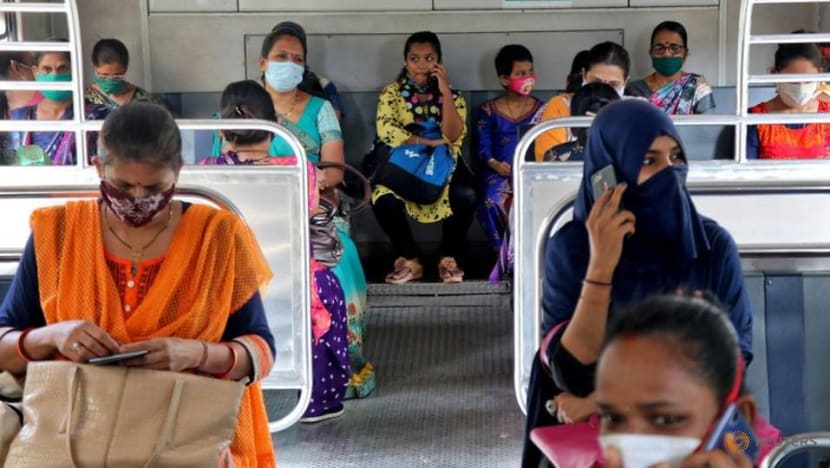India's female labour participation rate falls to 16.1% as pandemic hits jobs

Women wearing protective face masks commute in a suburban train in Mumbai, India, Oct 21, 2020. (Photo: Reuters/Niharika Kulkarni)
NEW DELHI: Female labour participation rate in India fell to 16.1 per cent during the July to September 2020 quarter, the lowest among the major economies, a government report said, reflecting the impact of the COVID-19 pandemic and a widening job crisis.
The percentage of women in the labour force had fallen to a record low of 15.5 per cent during the April to June 2020 quarter, when India imposed strict lockdowns to curb the spread of COVID-19 virus, said the report, released late Monday (Aug 2) by the Ministry of Statistics.
According to World Bank estimates, India has one of the lowest female labour force participation rates in the world. Less than a third of women – defined in the report as 15 or older – are working or actively looking for a job.
The female labour participation rate in India had fallen to 20.3 per cent in 2019 from more than 26 per cent in 2005, according to World Bank estimates, compared with 30.5 per cent in neighbouring Bangladesh and 33.7 per cent in Sri Lanka.
READ: As COVID-19 funeral pyres burn, India's rural economy goes up in smoke
WATCH: Gender gap widens in India as women lag behind on jobs and getting COVID-19 jabs
Most employed women in India are in low-skilled work, such as farm and factory labour and domestic help, sectors that have been hit hard by the pandemic.
The unemployment rate among women touched 15.8 per cent, compared with 12.6 per cent among male workers during the three months that ended in September 2020, the latest quarter for which data was released.
Most economic activities have resumed in the country after state governments eased pandemic curbs in response to a decline in coronavirus infections from May peaks. That is likely to help create more jobs for all workers, government officials said.
COMMENTARY: India’s COVID-19 crisis could cause long-lasting economic scars
India’s July unemployment rate fell to 6.95 per cent from the June figure of 9.17 per cent, data from the Centre for Monitoring Indian Economy (CMIE) showed on Monday.
Many private economists have warned that the slow pace of vaccination and a slump in consumer demand could hurt growth prospects, and the economy is unlikely to attain its pre-COVID size before March 2022.
Asia's third-largest economy, which shrank 7.3 per cent in the fiscal year ending in March, the worst recession in last seven decades, is expected to grow at 8 per cent to 9 per cent year-on-year in the current fiscal year.










